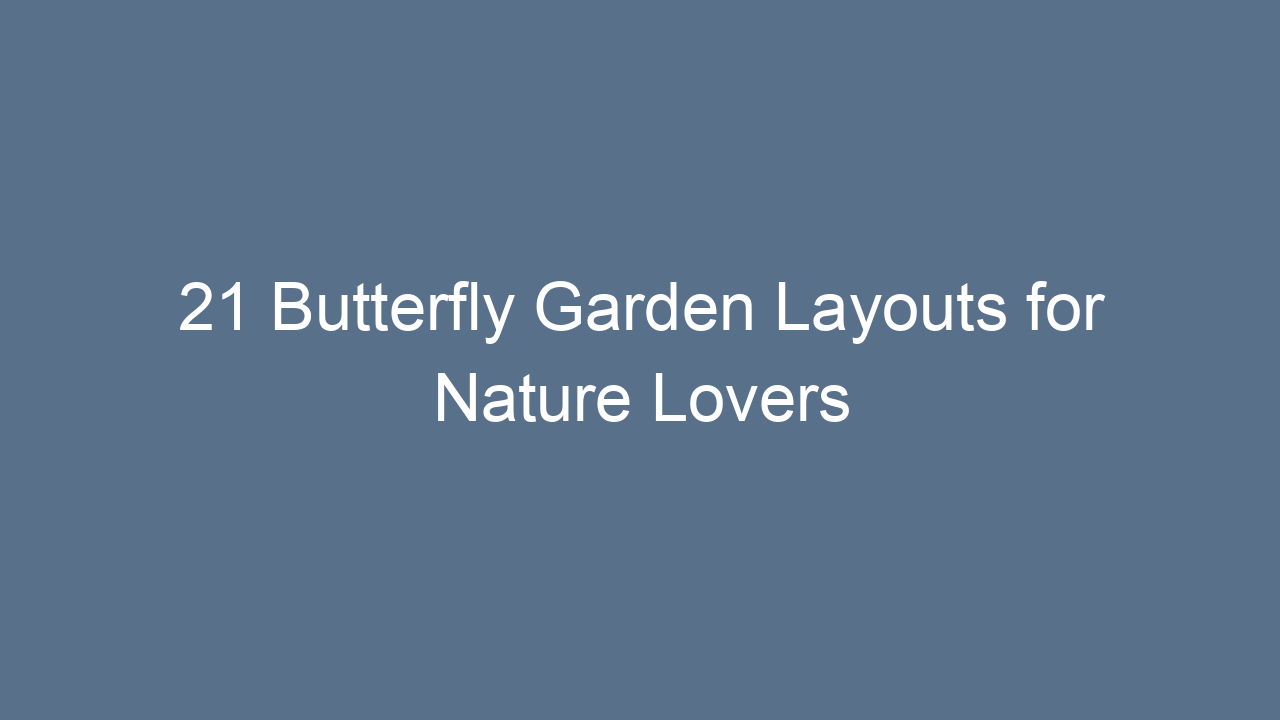21 Butterfly Garden Layouts for Nature Lovers

There’s something magical about stepping into a garden alive with fluttering wings. A butterfly garden layout is not just about flowers. It’s about creating a sanctuary where color, fragrance, and movement blend into a living artwork. Think of it as writing poetry with plants, where every bloom is a word and every butterfly is a rhyme.
When we design these spaces, we aren’t only decorating our backyards. We are shaping an ecosystem where pollinators find food, shelter, and safety. For nature lovers, it feels like opening your door to the sky. Let’s explore 21 unique butterfly garden layouts that can help you transform your space into a fluttering paradise.
In This Article
- 1 1. The Circular Haven Layout
- 2 2. The Corner Sanctuary Layout
- 3 3. The Pathway of Wings Layout
- 4 4. The Water’s Edge Retreat Layout
- 5 5. The Wild Meadow Layout
- 6 6. The Raised Bed Haven Layout
- 7 7. The Cottage Charm Layout
- 8 8. The Balcony Flutter Layout
- 9 9. The Spiral of Life Layout
- 10 10. The Four-Season Layout
- 11 11. The Pollinator Patchwork Layout
- 12 12. The Zen Minimalist Layout
- 13 13. The Tiered Terrace Layout
- 14 14. The Suntrap Layout
- 15 15. The Butterfly Maze Layout
- 16 16. The Vertical Garden Layout
- 17 17. The Native Plant Oasis Layout
- 18 18. The Circular Courtyard Layout
- 19 19. The Multi-Colored Rainbow Layout
- 20 20. The Butterfly Balcony Café Layout
- 21 21. The Pollinator Circuit Layout
1. The Circular Haven Layout
A circle has no beginning and no end, and that’s why this layout feels like an embrace. Imagine a round garden bed where nectar-rich flowers form layers—tall plants in the center, medium ones around them, and short ground covers on the edges. This design naturally draws butterflies into the middle, like guests gathering around a table.
With species like coneflowers, milkweed, and zinnias, you can keep blooms active from spring to fall. Add a shallow water dish at the center, and suddenly, the circle isn’t just beautiful—it’s a full-service stop for thirsty wings. For small yards, this layout creates both function and symmetry, making your space look welcoming yet intentional.
2. The Corner Sanctuary Layout
Not every butterfly garden needs a wide canvas. If you have an unused corner, transform it into a micro-habitat. Plant taller shrubs like lilac or butterfly bush against the fence, medium-sized flowers in the middle, and creeping thyme or lantana along the edge. This three-tier design makes the corner feel full and lush without taking up much space.
Butterflies love corners because they offer shelter from wind. You can even tuck in flat stones where they can sunbathe. For people living in cities or small homes, this layout proves you don’t need acres to invite beauty. It’s like finding poetry in a margin.
3. The Pathway of Wings Layout
Imagine walking down a garden path where butterflies rise like confetti with each step. This layout lines both sides of a walkway with nectar-rich blooms. Think lavender, cosmos, and coreopsis guiding you as if nature itself rolled out a red carpet.
Adding benches or stepping stones along the way makes the path not just practical but interactive. Each pause becomes a chance to notice tiny details—the flicker of wings, the way sunlight glints on petals. It’s a layout that combines movement with stillness, reminding us that beauty lies both in journey and pause.
4. The Water’s Edge Retreat Layout
Butterflies, like us, are drawn to water. If you have a pond, fountain, or even a birdbath, consider building your garden around it. Plant moisture-loving flowers like swamp milkweed and joe-pye weed along the edges. These blooms not only attract pollinators but also soften the water feature with color.
A trick for this layout is to place flat stones near the water. Butterflies often “puddle,” sipping minerals from damp soil. Watching them gather there feels like witnessing a secret tea party. It’s one of those designs that connects water, earth, and sky in a single glance.
5. The Wild Meadow Layout
If you’ve ever walked through a meadow buzzing with life, you know its untamed beauty. The wild meadow layout embraces that freedom. Instead of neat rows, scatter seeds of native wildflowers—black-eyed Susans, asters, goldenrod, and milkweed—across a section of your yard.
This layout works best when you let nature take the lead. Butterflies prefer diversity and randomness, and a meadow provides exactly that. To us, it looks spontaneous; to them, it’s survival. The joy of this style lies in its low maintenance and high reward—it’s like letting your yard tell its own story.
6. The Raised Bed Haven Layout
Sometimes soil conditions limit your choices. That’s where raised beds become heroes. By filling them with rich, well-drained soil, you can grow nectar-heavy blooms without worrying about poor ground conditions. Arrange several raised beds in a square or “L” shape, making it easy to move between them while tending to plants.
Butterflies benefit because raised beds warm up quickly in spring, encouraging earlier blooms. Plus, the height brings flowers closer to eye level, making the flutter of wings feel more intimate. For gardeners who love both order and abundance, this layout strikes the perfect balance.
7. The Cottage Charm Layout
The cottage garden style has long been a favorite for butterfly lovers. Picture overflowing beds of hollyhocks, phlox, delphiniums, and daisies blending into one another. The magic lies in abundance—no sharp lines, just waves of color.
Butterflies thrive here because nectar is everywhere. Each visit feels like a feast with endless courses. For humans, this design taps into nostalgia, reminding us of storybook homes and summer afternoons. It’s less about control and more about creating a living quilt of flowers and wings.
8. The Balcony Flutter Layout
Not everyone has a yard, but even a balcony can become a butterfly garden. Use containers of varying heights filled with marigolds, lantanas, pentas, and small herbs like oregano. Hanging baskets extend the space vertically, turning your balcony into a floating meadow.
Butterflies are surprisingly adaptable. As long as there’s food, they will visit—even in urban settings. A shallow dish with pebbles and water doubles as a butterfly bar. This layout reminds us that nature doesn’t demand size, only intention. Even in the city, wings can find a way.
9. The Spiral of Life Layout
A spiral layout feels almost mystical, drawing both the eye and butterflies inward. Imagine arranging flowers in a spiraling path, starting with shorter plants at the edges and taller ones at the center. Walking through it feels like a slow meditation, with each curve offering a new burst of color.
Butterflies enjoy this design because it mimics natural movement. They follow the spiral like we do, stopping at each nectar stop as if stations on a journey. It’s functional, whimsical, and deeply symbolic—a garden that feels like a story unfolding in circles.
10. The Four-Season Layout
Butterflies need food across different months, so a four-season layout ensures blooms never stop. Divide your garden into four sections: spring, summer, fall, and evergreen. Each section hosts plants that peak during its season—spring phlox and violets, summer milkweed and bee balm, autumn asters, and evergreen shrubs for winter shelter.
This design offers continuity, like a calendar written in flowers. For butterflies, it’s survival through the year. For us, it’s the joy of seeing color and life across all seasons. The layout teaches patience and reward—showing that beauty is not fleeting but cyclical.
11. The Pollinator Patchwork Layout
Sometimes the best design is one that blends butterflies with bees, hummingbirds, and other pollinators. This patchwork layout arranges square or rectangular beds like a quilt, each dedicated to different species. One square might host sunflowers, another milkweed, another salvia.
From above, it looks like a tapestry; on the ground, it feels like a buzzing festival. Butterflies love the diversity, and gardeners love the visual play. This design reminds us that nature is not about isolation but connection—many voices singing one song.
12. The Zen Minimalist Layout
For lovers of calm and clean design, a Zen-inspired butterfly garden offers simplicity without losing life. Focus on a few carefully chosen plants like lavender, Japanese maple, and camellias, paired with stones and gravel paths. The minimalism allows butterflies to stand out against a serene backdrop, almost like living art moving in slow motion.
Butterflies naturally gravitate to bright colors and nectar-rich flowers, so use small clusters instead of large beds. A bamboo water feature or shallow stone basin enhances tranquility and provides hydration. This layout reminds us that beauty doesn’t need clutter; sometimes, less truly is more. It’s meditation in motion—wings brushing past leaves, a gentle reminder of life’s quiet joys.
13. The Tiered Terrace Layout
If your garden slopes, embrace it with a tiered terrace design. Each level can host different plants, creating a natural hierarchy. Tall plants like butterfly bush on the top terrace, medium flowers like zinnias in the middle, and ground covers like creeping thyme on the bottom.
Terraces help with drainage and give butterflies a variety of perches. Walking along each level feels like climbing through layers of a living painting. This design is ideal for hilly backyards or spaces where elevation changes, offering both structure and a dynamic visual rhythm.
14. The Suntrap Layout
Butterflies love sun, so positioning your garden in a warm, sheltered spot ensures maximum activity. The suntrap layout places taller plants to the north or west to shield smaller blooms from harsh winds while leaving the sunniest areas open. This encourages butterflies to linger and feed.
Combine sun-loving flowers like marigolds, lantanas, and cosmos in clusters for best results. Add flat stones for sunbathing and shallow puddles for mineral intake. This layout proves that sometimes, simply observing the sun’s path can dictate the perfect garden design, blending intuition with natural behavior.
15. The Butterfly Maze Layout
For a playful twist, create a maze-style garden. Low hedges, flowering pathways, and hidden clearings encourage exploration—for both humans and butterflies. Plant nectar-rich flowers along paths and at intersections to reward wandering wings.
This layout adds fun and interactivity, making your garden feel like a living playground. Kids and adults alike can enjoy watching butterflies appear and disappear behind twists of flowers. It’s a garden design that celebrates curiosity and discovery, turning ordinary backyard time into a small adventure.
16. The Vertical Garden Layout
If space is tight or walls are available, a vertical butterfly garden brings flowers skyward. Use trellises, hanging planters, and wall-mounted containers to grow vines, flowering climbers, and herbs. This design maximizes vertical space while keeping the ground open for smaller plants and butterfly puddling areas.
Climbing plants like honeysuckle, morning glory, and sweet peas attract both butterflies and hummingbirds. Vertical layers mimic natural canopies, giving butterflies spots to rest and hide. For city dwellers, it’s a smart way to invite color, movement, and life without sacrificing floor space.
17. The Native Plant Oasis Layout
Butterflies thrive best on plants native to their region. A native plant oasis emphasizes local flora—milkweed, goldenrod, aster, or butterfly weed depending on your area. This layout reduces maintenance and creates a habitat perfectly suited for local pollinators.
Native plants often require less water and fertilizer, making them eco-friendly. Observing butterflies on plants evolved alongside them feels like stepping into a timeless natural scene. For environmental enthusiasts, this layout is both rewarding and responsible, supporting biodiversity while creating a beautiful garden.
18. The Circular Courtyard Layout
Perfect for homes with a central courtyard, this design uses concentric flower beds to draw butterflies inward. Plant in layers with nectar-rich blooms in the middle and short ground covers at the edges. Include a central fountain, birdbath, or butterfly puddling station.
The circular courtyard layout provides both symmetry and intimacy. Butterflies naturally gravitate toward the center, while visitors can enjoy 360-degree views. This layout works beautifully in urban or suburban settings, offering a private, fluttering retreat that feels larger than it is.
19. The Multi-Colored Rainbow Layout
Butterflies are drawn to vibrant hues. The rainbow layout arranges flowers by color bands, moving through red, orange, yellow, green, blue, and purple blooms. Not only does this attract a variety of butterfly species, but it also creates a visually striking garden that feels alive with movement and light.
Cluster flowers within each color band for impact. This design is perfect for gardeners who love bold, playful aesthetics. Watching butterflies move across the rainbow feels like watching living brushstrokes paint the air, creating an immersive sensory experience.
20. The Butterfly Balcony Café Layout
For urban gardeners with limited space, combine nectar plants with seating in a balcony café layout. Small tables, chairs, or benches tucked among containers create a social nook. Butterflies and people share the space, each enjoying their own version of leisure.
Use shallow water dishes, herbs like thyme or mint, and bright blooms like lantana, pentas, and marigolds. This layout proves that even a tiny balcony can host a vibrant, interactive butterfly haven. It turns everyday spaces into small, joyful sanctuaries—a reminder that connection with nature can fit in any lifestyle.
21. The Pollinator Circuit Layout
Finally, the pollinator circuit layout connects multiple small gardens into a continuous path. Each mini-garden hosts different flowers, nectar sources, or puddling spots, creating a “circuit” for butterflies to travel. This keeps them moving, feeding, and pollinating while encouraging extended visits.
It’s perfect for larger properties or communities. The design ensures variety and sustained interest, like a butterfly festival that never ends. Each stop has something unique, teaching us that nature thrives on movement, diversity, and interconnectedness. For the gardener, it offers a dynamic experience rather than a static scene.
Final Thoughts
Designing a butterfly garden is like writing a love letter to nature. Each layout offers a different way to connect with the delicate rhythm of wings and blooms. Whether your space is large or tiny, wild or orderly, there’s a layout for you. The key is to blend creativity, functionality, and ecology, so every flutter becomes a moment of joy.
A garden alive with butterflies is more than beauty—it’s a testament to care, patience, and observation. As you explore these 21 butterfly garden layouts, remember that the ultimate goal isn’t perfection. It’s presence: seeing, feeling, and celebrating life as it moves, dances, and lands gently in your backyard.






